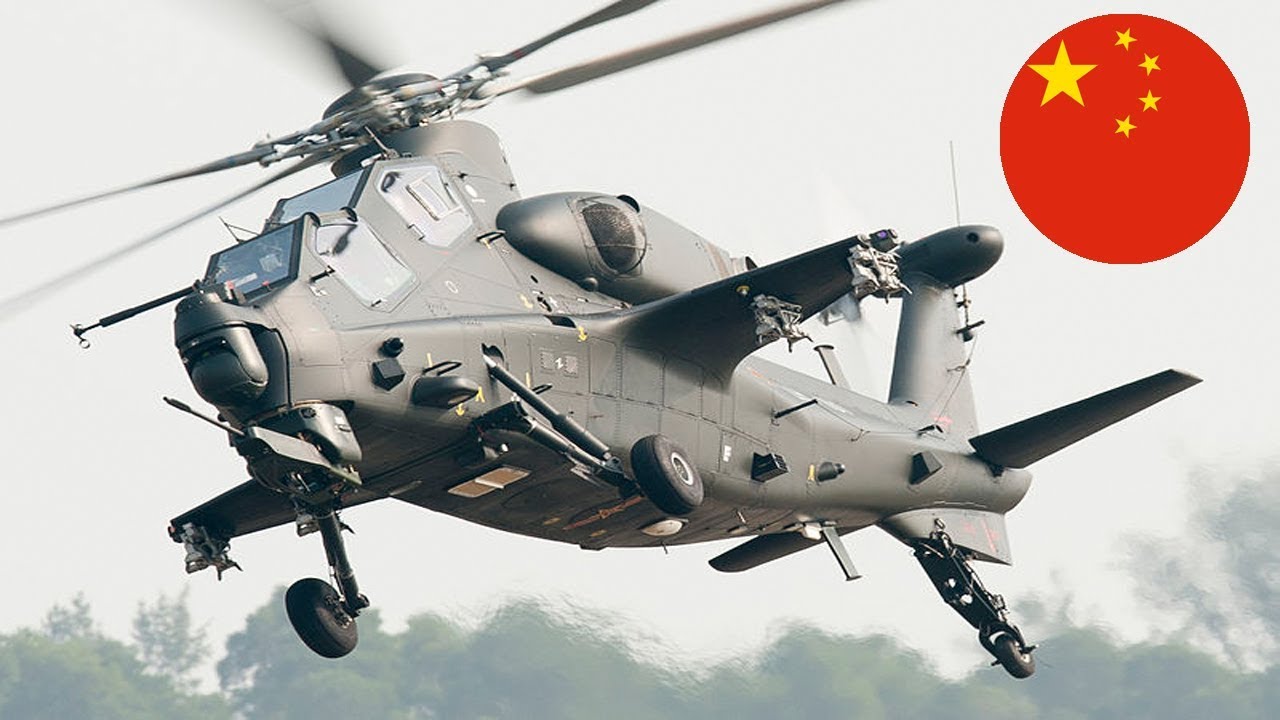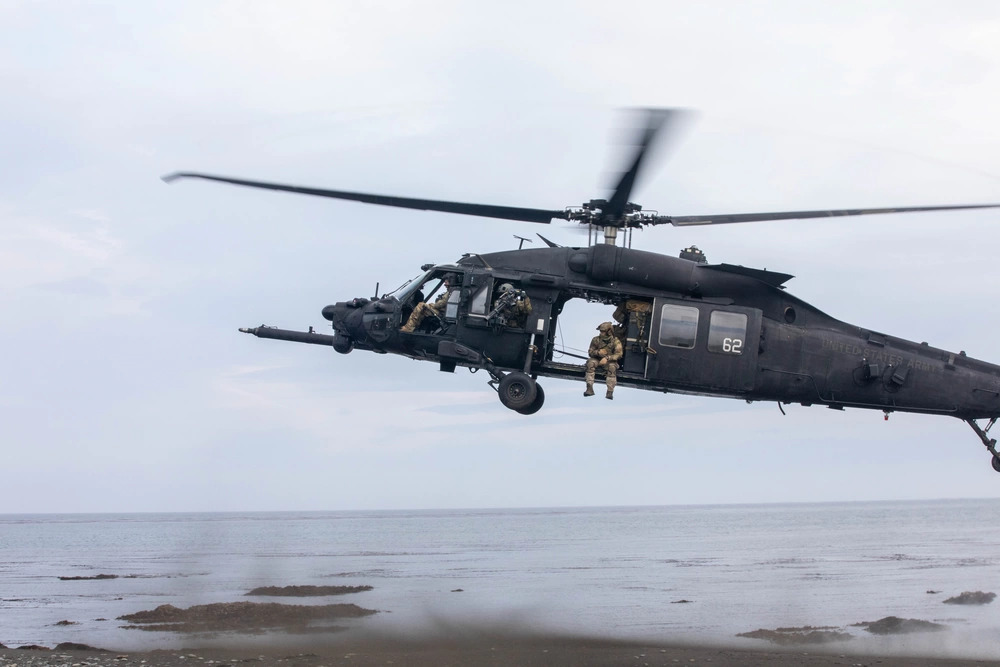U.S.-China “High-Stakes Aerial Standoff”? Chinese State Media Claims Intercepting Foreign Aircraft By Z-10 Attack Helo

China’s state broadcaster CCTV on Friday aired footage claiming to show a tense mid-air encounter between its military and a suspected U.S. Navy helicopter near the country’s coastline.
The incident, which reportedly occurred over the Taiwan Strait, featured what appeared to be a U.S.-made Sikorsky MH-60R Seahawk—a ship-based helicopter widely used by the U.S. Navy and its allies in the Pacific. The Chinese military didn’t specify when the encounter took place, only saying the foreign aircraft was closing in on Chinese airspace.
So far, there’s been no comment from the U.S. Defense Department or the U.S. Navy’s Seventh Fleet, which operates throughout the western Pacific.
The footage, broadcast on August 1, showed a Chinese Changhe Z-10 attack helicopter intercepting the suspected Seahawk.
The state-run Global Times described it as a “high-stakes aerial standoff.”

According to the pilot, Kong Xianghui, the foreign chopper came within about three miles of China’s territorial waters. Speaking to CCTV, he said he issued multiple radio warnings before engaging in a tense aerial dance that reportedly lasted over an hour.
At one point, Kong said, the helicopter vanished into cloud cover before reappearing and heading straight toward his aircraft from the left, then veering off at a distance of roughly 500 meters—about 1,650 feet.
“The maneuver was highly unprofessional and clearly meant to provoke,” Kong said. “We won’t tolerate this kind of behavior near our doorstep.”
CCTV praised the Chinese military for what it called the successful expulsion of the foreign aircraft from a “considerable distance.”
The timing of the footage’s release—on the 98th anniversary of the founding of the People’s Liberation Army—seemed symbolic, underscoring the deep military tensions between Beijing and Washington, even as both sides talk about easing broader economic strains.
MH-60R Helicopter
China’s sweeping claim over Taiwan doesn’t stop at land; it extends far into the surrounding waters. Beijing insists these seas are off-limits to foreign military operations, including those involving warships that may have deployed the MH-60R helicopter seen in its recent military video.
The MH-60R Seahawk, a naval workhorse derived from the Army’s UH-60 Black Hawk, is a highly versatile chopper. It’s designed for missions ranging from hunting submarines and tracking surface vessels to search and rescue and mid-sea logistics.
It operates from U.S. Navy destroyers, cruisers, and aircraft carriers—essentially any major surface ship.
Earlier, South Korea took delivery of its first MH-60R from the U.S. as part of a 12-unit order. But those helicopters won’t be operational until 2026, ruling out their involvement in the latest encounter.
That leaves one likely player. Right now, only the US and South Korea operate the MH-60R in Northeast Asia, said Su Tzu-yun, a senior fellow at Taiwan’s Institute for National Defense and Security Research, while talking to ‘Newsweek’. “So it was most probably an American chopper nearing Chinese water.”
Su also pointed out a key detail in the video. The pilot identifies himself as part of China’s army aviation and not the navy. That suggests the encounter occurred within the Eastern Theater Command’s jurisdiction, prompting the use of a ground forces helicopter like the Z10.
“The timing of the footage’s release on August 1, the anniversary of the PLA’s founding, was no coincidence “, Su added. “It’s aimed squarely at a domestic audience, a message of strength and vigilance from the Chinese military.”

Earlier Incidents
Tensions in the skies and at sea have been mounting steadily throughout 2025, with a string of aerial run-ins underscoring just how volatile the region has become.
Back in June, Beijing took a hard stance against what it sees as provocations under the banner of ‘Freedom of Navigation’ in the Taiwan Strait. When Taiwan’s Democratic Progressive Party claimed that 46 PLA aircraft had crossed the so-called median line in a single day, speculation quickly linked the incident to the recent transits by British and Japanese naval vessels and a high-profile visit from US lawmakers.
China’s foreign ministry was quick to respond. Spokesperson Guo Jiakun reaffirmed that the Taiwan issue touches directly on China’s sovereignty and territorial integrity.
“We respect lawful passage in the strait. But we will not tolerate threats to our national security disguised as navigation rights,” Guo said.
Earlier in February, another flashpoint emerged. This time over the South China Sea. A Chinese Navy Z9 helicopter intercepted a Philippine surveillance plane during a routine patrol near Scarborough Shoal. Manila didn’t hold back, calling it a ‘blatantly hazardous action’.
The Philippine Coast Guard said the helicopter closed in alarmingly close, just three meters from a civilian aircraft carrying journalists, flying barely 700 ft above the water.
The US ambassador to Manila, MaryKay Carlson, swiftly condemned the Chinese navy’s ‘dangerous’ maneuvers, urging Beijing to respect international norms and avoid coercive behavior.
By May, China’s state broadcaster CCTV reported a sharp rise in helicopter standoffs with foreign militaries over the East China Sea, 11 separate incidents in just 10 days. Some encounters came within 10 meters, according to the report. CCTV didn’t name which foreign military was involved, but described the activity as a pattern of ‘provocations’.
In July, the heat turned up again, this time between China and Japan. Both sides accused the other of aggressive behavior after a series of close aerial encounters. Tokyo said a Chinese JH7 fighter bomber had made several ‘unusual approaches’ toward a Japanese YS 11EB electronic surveillance aircraft over two consecutive days.
Beijing fired back, accusing Japanese planes of repeatedly entering China’s air defense identification zone over the East China Sea.
Each of these incidents, while isolated, weaves into a much larger pattern – a region on edge, where even routing patrols risk spiraling into crisis.
US vs China In The Taiwan Strait
The Taiwan Strait, a narrow but strategic stretch of water just 80 miles wide at its tightest point, separates mainland China from Taiwan, a self-governed island that Beijing insists is part of its territory. A claim firmly rejected by Taipei.
Washington walks a careful line on the matter. While the US doesn’t officially recognize Taiwan as a sovereign country, it also doesn’t accept Beijing’s sweeping maritime claims over the strait.
Instead, successive US administrations have routinely sent warships and aircraft through the strait to assert what they view as the right to freedom of navigation and overflight, under international law.
According to the United Nations Convention on the Law of the Sea (UNCLOS), coastal states control resources in an exclusive economic zone stretching 200 nautical miles from their shores. However, full sovereignty stops at the 12 nautical mile mark.
Military vessels under UNCLOS are permitted to pass through territorial waters under ‘innocent passage’ rules, so long as they are not conducting any military operations like launching aircraft or weapons training.
Beijing argues that it has jurisdiction over the Taiwan Strait but has carefully avoided declaring it as internal waters, a move that would significantly impact international shipping. The US, for its part, continues to treat the strait as international waters, asserting that no single country has the right to control access.
Between 2020 and 2021, US Navy ships and surveillance planes made regular, often monthly passages through the strait, each one sparking a reaction from China.
Under the Trump administration, three such missions took place in 2025 alone, including a mid-July overflight. The US logged nine transits in 2024 and 11 the year before.
The most recent known transit happened in April, when the USS William P. Lawrence, an Arleigh Burke-class guided missile destroyer, sailed through the Strait. This Flight IIA variant of the destroyer, introduced in 2000, is capable of carrying two MH-60R Seahawk helicopters, the same model at the center of China’s latest interception footage.
These operations aren’t just symbolic. Like US freedom of navigation patrols in the South China Sea, they are meant to challenge China’s expansive maritime claims and keep key shipping lanes open to all. That said, the Taiwan Strait remains a bustling thoroughfare for all kinds of vessels on any given day.
In early July, when ship tracking data showed a vessel entering the Taiwan Strait identifying itself as a “US government vessel”, the US Navy’s Seventh Fleet quickly clarified: No US Navy assets were involved at that time.
- Questions and Answers
- Opinion
- Motivational and Inspiring Story
- Technology
- True & Inspiring Quotes
- Live and Let live
- Focus
- Art
- Causes
- Crafts
- Dance
- Drinks
- Film/Movie
- Fitness
- Food
- Spiele
- Gardening
- Health
- Startseite
- Literature
- Music
- Networking
- Andere
- Party
- Religion
- Shopping
- Sports
- Theater
- Wellness
- News
- Culture

